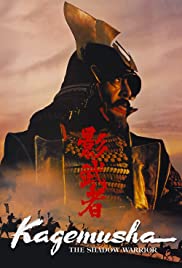
KAGEMUSHA
Japan, 1980, 159 minutes, Colour.
Tatsuya Nakadai.
Directed by Akira Kurosawa.
Japanese master director Akira Kurosawa has made superb films for decades, including Rashomon, Living and a series of Samurai classics. After working in Russia with Dersu Uzala, he has returned to 16th century Japanese military history, with an epic treatment of warlord clashes and the story of a thief reprieved from the gallows to be a double for a noble - a shadow warrior, a Kagemusha.
The battle sequences are spectacular but unclear. Much better is the portrait of the thief, his fears, successes, initiatives, his relating to the noble's grandson, his quick rejection and downfall. Kurosawa, a former painter, stylises the historical sweep, the nightmare imagination and the personal drama.
Kagemusha is a spectacular Samurai film written and directed by veteran Akira Kurosawa. He made this film at the age of 70 (with the financial and production help of Francis Ford Coppola and George Lucas).
Kurosawa made many Samurai films in the 1950s including Rashomon, The Seven Samurai, Throne of Blood. He also made many dramas and thrillers. In the 70s he made only to films, moving into colour photography (dear to him as an artist): Dodes'kaden and the Oscar winning Dersu Uzala. After Kagemusha, he made his Samurai variation of the King Lear story with touches of Macbeth, Ran (Chaos) as well as his beautiful legacy of his artistic sensibility, Akira Kurosawa's Dreams.
This film is set in the 16th century, shows rival groups in Japan and their warring clashes. It focuses on the substitute for the leader who often goes in his place in battle and who can keep alive the fiction that the leader is
still at the helm, even if he is dead. In this film, a robber is given a reprieve and acts as the Kagemusha for the leader. He enters into the role with great feeling, even becoming part of the royal family. However, the truth is revealed and he is discarded, dying in battle.
1. The work of Akira Kurosawa: The Samurai films, Japanese history, heroism? Politics? Kurosawa as visual artist?
2. The colour photography, the pageantry, the settings, the courts, the battlefields, tableau? The focus on interactions? The tableau for characters? The musical score?
3. Audience response to the Samurai traditions? Heroism? Martial arts? Their place in Japanese history? The feudal lords and their kingdoms, battles: the warrior hero? The conventions of the samurai film?
4. The title? The lord and his brother taking his place? The bandit and his becoming the Kagemusha? In the battles, in the court? His finally being discarded?
5. The impact of the epic style: content, history, battles? Audience response to the pageantry and the history?
6. The introduction: the discussion between the lord and the bandit, the period of time, the understanding of the customs? The lord, his brother, the thief? The establishing of the situation?
7. The power struggles in the feudal system? The battles and the staging of the battles? Power struggles? The family, the leadership, the death of the Lord?
8. The character of the thief (and the actor playing both brother and thief)? As character, a type, being saved from execution, his being trained as the Kagemusha, the variety of tests, his relationship, with the women, the child? His attempt at stealing?
9. The portrait of the rival Lords in themselves? Their kingdoms, power struggles? The staging of the battles? The talk about the leader? The battle and the tests? The assassination, the analysis afterwards - and the puzzle of the
survival of the Lord?
10. The role of the Kagemusha in Japanese history, the taking the place of the Lord? deceptions? The thief becoming the Kagemusha and the Lord? The court believing him? The son attacking, the battle, his remaining immobile in the tradition of the Lord? The fierce battles and the victory?
11. The thief and the boy, the riding, becoming his father? The women and the discovery of the identity of the thief? His finally being ousted? The funeral of the Lord?
12. The climax of the final battle, guns and artillery, the defeat? The thief, his place in the battle, the bearing of the standard, the pathos of his death?
13. The blend of history and stylised portraiture, realism? Japanese society and values? Society and individuals? Power, battles and war?